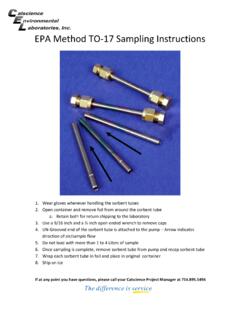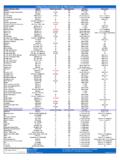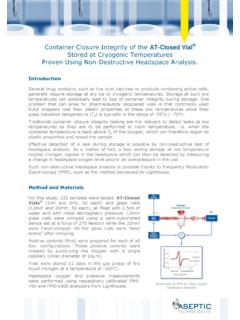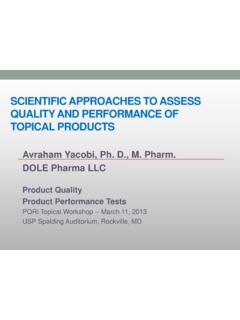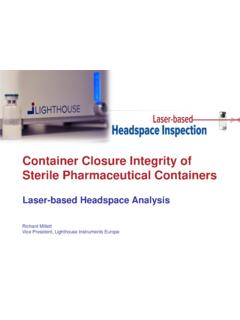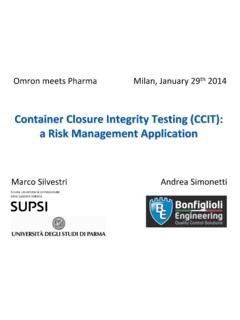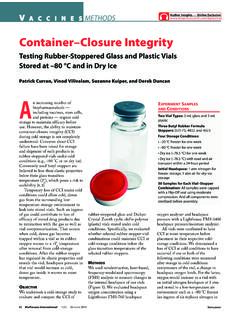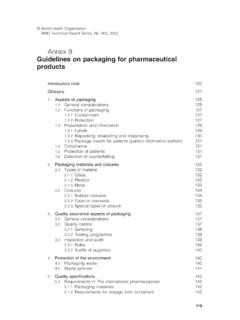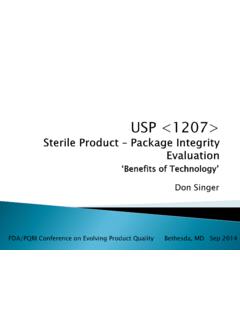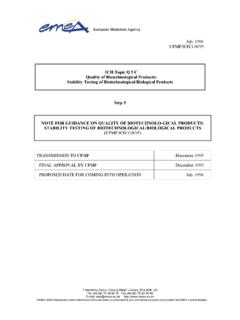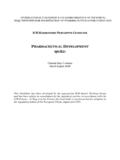Transcription of Container Closure Integrity Testing - Eurofins USA
1 9115 0618 Container Closure Integrity TestingA critical step in understanding the biological safety and suitability of a Container is the ability to characterize the materials and chemicals that have the potential to migrate through Container Closure system components and contaminate the drug the driving forces behind safety evaluation of materials and Container Closure systems in the US, the United States Pharmacopeia (USP) and Food and Drug Administration (FDA) enforce stringent requirements for Container Closure Integrity Testing (CCIT).Historically, Dye Immersion and Microbial Immersion (both probabilistic tests) were the two leading methods for Container Closure Integrity Testing .
2 Recently USP issued guidance to require deterministic methods to achieve more reproducible and predictable results for CCIT Testing . While we do offer the traditional Dye Immersion and Microbial Challenge Testing for Container Closure systems, these methodologies are not considered deterministic. These tests are also destructive to the samples under test, and typically require a significant number of units for method development and Lancaster Laboratories is committed to offering the most up-to-date methods for Testing the Closure systems for final drug product packaging and has invested in state-of-the-art instrumentation to meet these regulatory guidelines and verify the safety of your Container Closure system.
3 In addition to the probabilistic methods, such as Dye Ingress and Microbial Immersion, we also offer deterministic methods, such as Vacuum Decay, Pressure Decay, High Voltage Leak Detection, Oxygen Headspace and Helium Leak Detection. Each of these methods offers unique capabilities with ideal applications. We can help you determine which method is best for your project Choose Eurofins Lancaster Laboratories? We have more than 15 years of experience developing and executing methods for hundreds of Container Closure Testing projects utilizing various Container types. We offer seven techniques for CCIT Testing . Our techniques accommodate various packaging configurations.
4 Our methods can minimize the number of samples required for MethodsVacuum DecayInstrumentation: VeriPac 455-M5 Vacuum Decay Description: Measures leaks by vacuum decay based upon ASTM F2338. Performs leak Testing with sensitivity to detect leaks down to approximately 5 microns. This option reduces the amount of valuable finished drug product required for stability Testing as the Testing is non-destructive to the sample, and therefore, the same sample can be used for other laboratory tests typically required during stability studies once the vacuum decay test has been Application: This technology is suitable for leak Testing on Container / Closure systems such as syringes and vials.
5 Because this method is non- destructive to the sample under test, it is a great option for leak Testing both before and during stability photoGlobal Services:Chemistry/BiochemistryCell Banking ServicesFacility & Process ValidationMethod Development & ValidationMicrobiologyMolecular & Cell BiologyRaw Materials TestingRelease TestingResiduals & Impurities TestingStability Testing & StorageViral Clearance & Viral SafetyProfessional Scientific Services Facilities:Lancaster, PA717-656-2300 Portage, MI269-323-3366A member of the EurofinsBioPharma Product TestingGroup The largest network ofharmonized bio/pharmaceuticalGMP product Testing labs DecayInstrumentation: TM Electronics BT Integra Burst, Creep and Leak TesterDescription: Measures leaks by pressure decay based upon ASTM Application: This technology accommodates both seal and package Integrity Testing for flexible packaging, such as bags and pouches.
6 This is a destructive Voltage Leak DetectionInstrumentation: E-Scan 655 MicroCurrent High VoltageLeak Detector (HVLD)Description: Detects package defects using an electrical Application: This technology is suitable for use with liquid-filled parenteral drug product glass vials and syringes, where the packaging is far less conductive than the liquid HeadspaceInstrumentation: FMS-760 Oxygen Headspace Analyzer Description: Uses Frequency Modulation Spectroscopy (FMS) to detect oxygen in the headspace of transparent rigid containers and measures rise or fall in the oxygen levels in the Container s headspace to identify a potential leak. It can also be used to determine the rate of oxygen permeation into a sealed Container over Application: Because this method is non- destructive to the sample under test, it is a great option for leak Testing parenteral containers both before and during stability studies.
7 This technology is also used during package development to verify inherent package Integrity and maximum allowable leakage limit (MALL) through leak rate Leak DetectionInstrumentation: Helium Mass Spectrometer Tracer, Gas Detection, Vacuum ModeDescription: Quantitates the flow rate of helium from leaks in packaging after having been flooded with helium as a tracer gas. If a defect is present, the helium is then drawn out of the packaging through the defect by vacuum and detected using a mass spectrometer. This method is the most sensitive option, allowing for the detection of defects as small as Application: This technology is suitable for package development to verify inherent package Integrity and maximum allowable leakage limit (MALL).
8 This technique is applicable to a wide variety, of package types, can isolate and identify leak location, and can directly measure leak flow MethodsDye Ingress TestingSample and positive control packages are fully submerged in a dye bath. A vacuum pressure of about atmospheres is applied for a specific amount of time, samples are returned to atmospheric pressure, and then a positive pressure of about 2 atmospheres may be applied for a specific amount of time. The packages are then visually compared to a sensitivity solution of a known concentration of dye to evaluate the samples for the presence of dye inside the packages.
9 Alternatively, the solutions inside the packages can be tested for the presence of dye using a UV/Vis Immersion TestingGeneric in-house methods are available and may be customized based on individual Testing requirements. Techniques offered include Vacuum, Static, or Challenge Organism.
